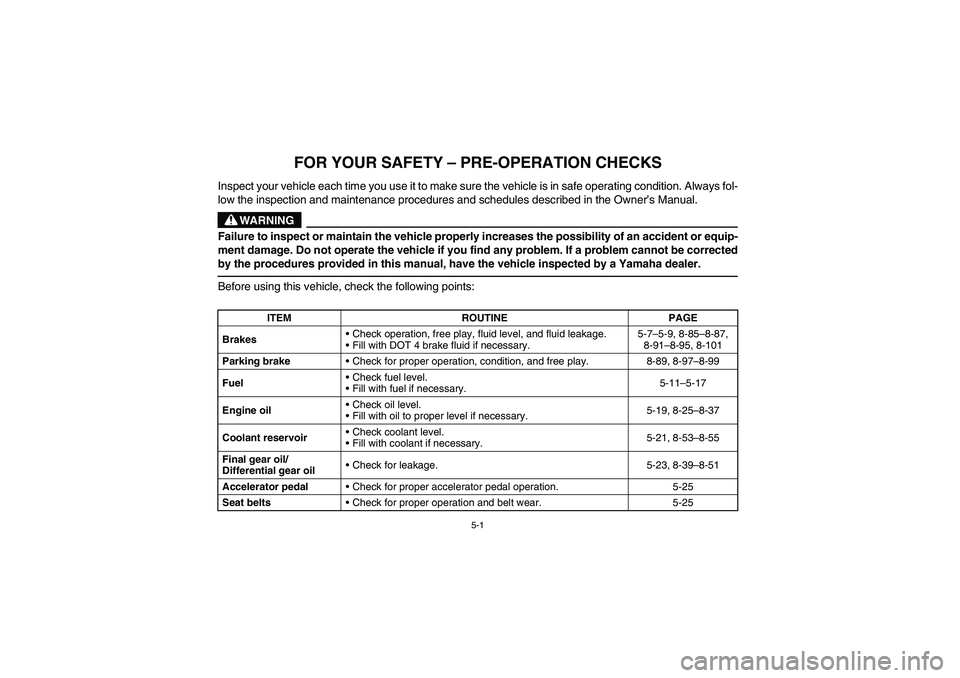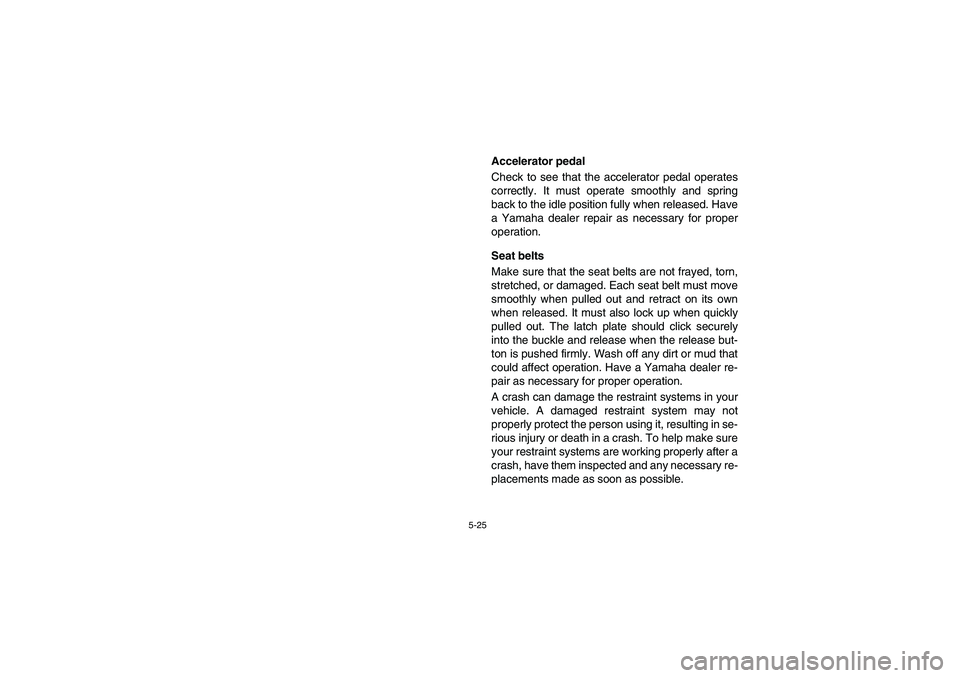Page 82 of 506
4-13 1. Helmet/Seat belt indicator light “ / ”
1. Témoin de port de casque/ceinture de sécurité “ / ”
1. Luz indicadora del casco/asiento “ / ”
Helmet/Seat belt indicator light “ / ”
The indicator light comes on when the key is
turned to “ON” to remind the occupants to always
wear a helmet and to fasten their seat belt. The in-
dicator light stays on even when the seat belt is
properly latched. If the indicator light does not
come on when the key is turned to “ON”, have a
Yamaha dealer check the electrical circuit.
EE.book Page 13 Tuesday, April 15, 2008 9:11 AM
Page 110 of 506
4-41 1. Seat belt (× 2)
1.Ceinture de sécurité (× 2)
1. Cinturón de seguridad (× 2)
a. Unlock. b. Open.
a. Déverrouiller. b. Ouvrir.
a. Desbloquear. b. Abrir.
EVU00340
Seat belts
This vehicle is equipped with three-point seat belts
for both the operator and the passenger. Always
wear the seat belts properly while riding in the ve-
hicle. See pages 7-15–7-21 for more information.
EVU01191
Glove compartmentNOTICETo protect from damage, do not put metal
products, like tools or sharply edged products,
directly in the glove compartment. If they must
be stored, wrap them in appropriate cushion-
ing material.
EE.book Page 41 Tuesday, April 15, 2008 9:11 AM
Page 152 of 506

5-1
EVU01200
1 -FOR YOUR SAFETY – PRE-OPERATION CHECKS
Inspect your vehicle each time you use it to make sure the vehicle is in safe operating condition. Always fol-
low the inspection and maintenance procedures and schedules described in the Owner’s Manual.
WARNING
Failure to inspect or maintain the vehicle properly increases the possibility of an accident or equip-
ment damage. Do not operate the vehicle if you find any problem. If a problem cannot be corrected
by the procedures provided in this manual, have the vehicle inspected by a Yamaha dealer.Before using this vehicle, check the following points:
ITEM ROUTINE PAGE
BrakesCheck operation, free play, fluid level, and fluid leakage.
Fill with DOT 4 brake fluid if necessary.5-7–5-9, 8-85–8-87,
8-91–8-95, 8-101
Parking brakeCheck for proper operation, condition, and free play. 8-89, 8-97–8-99
FuelCheck fuel level.
Fill with fuel if necessary.5-11–5-17
Engine oilCheck oil level.
Fill with oil to proper level if necessary.5-19, 8-25–8-37
Coolant reservoirCheck coolant level.
Fill with coolant if necessary.5-21, 8-53–8-55
Final gear oil/
Differential gear oilCheck for leakage. 5-23, 8-39–8-51
Accelerator pedalCheck for proper accelerator pedal operation. 5-25
Seat beltsCheck for proper operation and belt wear. 5-25
EE.book Page 1 Tuesday, April 15, 2008 9:11 AM
Page 176 of 506

5-25
EVU00450
Accelerator pedal
Check to see that the accelerator pedal operates
correctly. It must operate smoothly and spring
back to the idle position fully when released. Have
a Yamaha dealer repair as necessary for proper
operation.
EVU00460
Seat belts
Make sure that the seat belts are not frayed, torn,
stretched, or damaged. Each seat belt must move
smoothly when pulled out and retract on its own
when released. It must also lock up when quickly
pulled out. The latch plate should click securely
into the buckle and release when the release but-
ton is pushed firmly. Wash off any dirt or mud that
could affect operation. Have a Yamaha dealer re-
pair as necessary for proper operation.
A crash can damage the restraint systems in your
vehicle. A damaged restraint system may not
properly protect the person using it, resulting in se-
rious injury or death in a crash. To help make sure
your restraint systems are working properly after a
crash, have them inspected and any necessary re-
placements made as soon as possible.
EE.book Page 25 Tuesday, April 15, 2008 9:11 AM
Page 178 of 506
5-27
EVU01230
Steering
Park on level ground. Turn the steering wheel right
and left. Check for excessive free play, abnormal
noises, or a rough feeling. Have a Yamaha dealer
repair as necessary for proper operation.
EVU00470
Fittings and fasteners
Always check the tightness of chassis fittings and
fasteners before a ride. Take the vehicle to a
Yamaha dealer or refer to the Service Manual for
correct tightening torque.
EVU00480
Lights
Check the headlights, tail/brake lights, and helmet/
seat belt indicator light to make sure they are in
working condition. Repair as necessary for proper
operation.
EE.book Page 27 Tuesday, April 15, 2008 9:11 AM
Page 224 of 506
7-5
As the owner/operator, it is your responsibility to
protect yourself and your passenger from acci-
dents, including rollovers. The Rhino has many
features, including a protective structure and seat
belts, to help protect occupants, but the best way
to avoid injuries is to avoid accidents. There is a
risk of injury or death in any accident, even with
these safety features.
EE.book Page 5 Tuesday, April 15, 2008 9:11 AM
Page 230 of 506
7-11 1. Passenger handhold 2. Seat belt
3. Door
1. Poignée du passager 2. Ceinture de sécurité
3. Portière
1. Asidero del pasajero 2. Cinturón de seguridad
3. Puerta
1
22
3
1. Door
1. Portière
1. Puerta
1
Occupant protection system
WARNING
Do not make changes to the occupant protec-
tion system. If you install aftermarket products
or have your vehicle modified, you may put
yourself and others at greater risk of serious
injury or death. You are responsible for any
such changes to the vehicle.The Rhino comes with a variety of features to help
reduce the risk of driver and passenger injury.
These features work together, and when properly
used, these features will help protect the occu-
pants in the event of an accident. If these features
are not used properly, they can cause injury.
EE.book Page 11 Tuesday, April 15, 2008 9:11 AM
Page 232 of 506
7-13 1. Passenger handhold
1. Poignée du passager
1. Asidero del pasajero
1
Protective structure
The vehicle cage/frame provides a protective
structure that helps limit intrusions by branches or
other objects and may reduce your risk of injury in
accidents. The protective structure will not protect
occupants in all rollovers or accidents.
Body parts outside of vehicle can be struck by
passing objects or crushed during vehicle rollover.
Do not put your hands or feet outside of the vehicle
for any reason. Do not hold onto the door, cage/
frame or hip restraint bar. Wear your seat belt and
helmet.
If you think or feel that the vehicle may tip or roll,
do not put your hands or feet outside the vehicle
for any reason. You will not be able to stop the ve-
hicle from tipping over using your body. Any part of
your body (arms, legs, or head) outside of the ve-
hicle can be crushed by the vehicle cage/frame.
EE.book Page 13 Tuesday, April 15, 2008 9:11 AM